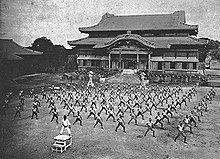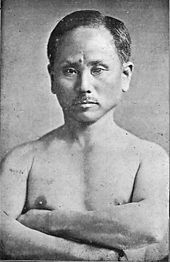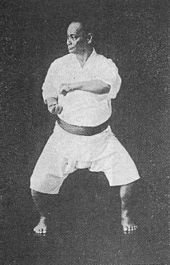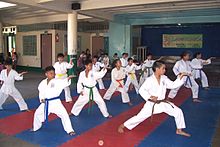Karate History
Karate (空手) particularly Fujian White Crane. Karate is now predominantly a striking art [kaɾate] ( Okinawan pronunciation: [kaɽati]) is a martial art developed in the Ryukyu Kingdom. It developed from the indigenous Ryukyuan martial arts (called te (手), "hand"; tii in Okinawan) under the influence of Chinese martial arts, particularly Fujian White Crane. Karate is now predominantly a striking art using punching, kicking, knee strikes, elbow strikes and open-hand techniques such as knife-hands, spear-hands and palm-heel strikes. Historically, and in some modern styles, grappling, throws, joint locks, restraints and vital-point strikes are also taught. A karate practitioner is called a karateka (空 手家).
The Empire of Japan annexed the Ryukyu Kingdom in 1879. Karate came to mainland Japan in the early 20th century during a time of migration as Ryukyuans, especially from Okinawa, looked for work in the main islands of Japan.[4] It was systematically taught in Japan after the Taishō era of 1912–1926.[5] In 1922, the Japanese Ministry of Education invited Gichin Funakoshi to Tokyo to give a karate demonstration. In 1924, Keio University established the first university karate club in mainland Japan, and by 1932 major Japanese universities had karate clubs.[6] In this era of escalating Japanese militarism,[7] the name was changed from 唐手 ("Chinese hand" or "Tang hand")[8] to 空手 ("empty hand") – both of which are pronounced karate in Japanese – to indicate that the Japanese wished to develop the combat form in Japanese style.[9] After World War II, Okinawa became (1945) an important United States military site and karate became popular among servicemen stationed there.
The martial arts movies of the 1960s and 1970s served to greatly increase the popularity of martial arts around the world, and English-speakers began to use the word karate in a generic way to refer to all striking-based Asian martial arts.[12] Karate schools (dōjōs) began appearing around the world, catering to those with casual interest as well as those seeking a deeper study of the art. Shigeru Egami, Chief Instructor of the Shotokan dōjō, opined that "the majority of followers of karate in overseas countries pursue karate only for its fighting techniques ... Movies and television ... depict karate as a mysterious way of fighting capable of causing death or injury with a single blow ... the mass media present a pseudo art far from the real thing."[13] Shōshin Nagamine said: "Karate may be considered as the conflict within oneself or as a life-long marathon which can be won only through self-discipline, hard training and one's own creative efforts."[14]
On 28 September 2015 karate featured on a shortlist (along with baseball, softball, skateboarding, surfing, and sport climbing) for consideration for inclusion in the 2020 Summer Olympics. On 1 June 2016 the International Olympic Committee's executive board announced they were supporting the inclusion of all five sports (counting baseball and softball as only one sport) for inclusion in the 2020 Games.
Web Japan (sponsored by the Japanese Ministry of Foreign Affairs) claims that karate has 50 million practitioners worldwide,[15] while the World Karate Federation claims there are 100 million practitioners around the world.[16]
Etymology
Karate was originally written as "Chinese hand" (唐手, literally "Tang dynasty hand") in kanji. It was changed to a homophone meaning empty hand (空手) in 1935. The original use of the word "karate" in print is attributed to Ankō Itosu; he wrote it as "唐手". The Tang Dynasty of China ended in AD 907, but the kanji representing it remains in use in Japanese language referring to China generally, in such words as "唐人街" meaning Chinatown. Thus the word "karate" was originally a way of expressing "martial art from China."
Since there are no written records it is not known definitely whether the kara in karate was originally written with the character 唐 meaning China or the character 空 meaning empty. During the time when admiration for China and things Chinese was at its height in the Ryūkyūs it was the custom to use the former character when referring to things of fine quality. Influenced by this practice, in recent times karate has begun to be written with the character 唐 to give it a sense of class or elegance.
— Gichin Funakoshi[17]
The first documented use of a homophone of the logogram pronounced kara by replacing the Chinese character meaning "Tang Dynasty" with the character meaning "empty" took place in Karate Kumite written in August 1905 by Chōmo Hanashiro (1869–1945). Sino-Japanese relations have never been very good and especially at the time of the Japanese invasion of Manchuria, referring to the Chinese origins of karate was considered politically incorrect.[18]
In 1933, the Okinawan art of karate was recognized as a Japanese martial art by the Japanese Martial Arts Committee known as the "Butoku Kai". Until 1935, "karate" was written as "唐手" (Chinese hand). But in 1935, the masters of the various styles of Okinawan karate conferred to decide a new name for their art. They decided to call their art "karate" written in Japanese characters as "空手" (empty hand).[19]
Another nominal development is the addition of dō (道:どう) to the end of the word karate. Dō is a suffix having numerous meanings including road, path, route and way. It is used in many martial arts that survived Japan's transition from feudal culture to modern times. It implies that these arts are not just fighting systems but contain spiritual elements when promoted as disciplines. In this context dō is usually translated as "the way of ___". Examples include aikido, judo, kyūdō and kendo. Thus karatedō is more than just empty hand techniques. It is "The Way of the Empty Hand".
History
Okinawa

Karate training in front of Shuri Castle in Naha (1938)
Karate began as a common fighting system known as te (Okinawan: ti) among the Pechin class of the Ryukyuans. After trade relationships were established with the Ming dynasty of China in 1372 by King Satto of Chūzan, some forms of Chinese martial arts were introduced to the Ryukyu Islands by the visitors from China, particularly Fujian Province. A large group of Chinese families moved to Okinawa around 1392 for the purpose of cultural exchange, where they established the community of Kumemura and shared their knowledge of a wide variety of Chinese arts and sciences, including the Chinese martial arts. The political centralization of Okinawa by King Shō Hashi in 1429 and the policy of banning weapons by King Shō Shin in 1477, later enforced in Okinawa after the invasion by the Shimazu clan in 1609, are also factors that furthered the development of unarmed combat techniques in Okinawa.
There were few formal styles of te, but rather many practitioners with their own methods. One surviving example is the Motobu-ryū school passed down from the Motobu family by Seikichi Uehara.[20] Early styles of karate are often generalized as Shuri-te, Naha-te, and Tomari-te, named after the three cities from which they emerged.[19] Each area and its teachers had particular kata, techniques, and principles that distinguished their local version of te from the others.
Members of the Okinawan upper classes were sent to China regularly to study various political and practical disciplines. The incorporation of empty-handed Chinese Kung Fu into Okinawan martial arts occurred partly because of these exchanges and partly because of growing legal restrictions on the use of weaponry. Traditional karate kata bear a strong resemblance to the forms found in Fujian martial arts such as Fujian White Crane, Five Ancestors, and Gangrou-quan (Hard Soft Fist; pronounced "Gōjūken" in Japanese).[21] Many Okinawan weapons such as the sai, tonfa, and nunchaku may have originated in and around Southeast Asia.
Sakukawa Kanga (1782–1838) had studied pugilism and staff (bo) fighting in China (according to one legend, under the guidance of Kosokun, originator of kusanku kata). In 1806, he started teaching a fighting art in the city of Shuri that he called "Tudi Sakukawa," which meant "Sakukawa of China Hand." This was the first known recorded reference to the art of "Tudi," written as 唐手. Around the 1820s Sakukawa's most significant student Matsumura Sōkon (1809–1899) taught a synthesis of te (Shuri-te and Tomari-te) and Shaolin (Chinese 少林) styles.[22] Matsumura's style would later become the Shōrin-ryū style.
Matsumura taught his art to Itosu Ankō (1831–1915) among others. Itosu adapted two forms he had learned from Matsumura. These are kusanku and chiang nan.[23] He created the ping'an forms ("heian" or "pinan" in Japanese) which are simplified kata for beginning students. In 1901, Itosu helped to get karate introduced into Okinawa's public schools. These forms were taught to children at the elementary school level. Itosu's influence in karate is broad. The forms he created are common across nearly all styles of karate. His students became some of the most well-known karate masters, including Gichin Funakoshi, Kenwa Mabuni, and Chōki Motobu. Itosu is sometimes referred to as "the Grandfather of Modern Karate.
In 1881, Higaonna Kanryō returned from China after years of instruction with Ryu Ryu Ko and founded what would become Naha-te. One of his students was the founder of Gojū-ryū, Chōjun Miyagi. Chōjun Miyagi taught such well-known karateka as Seko Higa (who also trained with Higaonna), Meitoku Yagi, Miyazato Ei'ichi, and Seikichi Toguchi, and for a very brief time near the end of his life, An'ichi Miyagi (a teacher claimed by Morio Higaonna).
In addition to the three early te styles of karate a fourth Okinawan influence is that of Uechi Kanbun (1877–1948). At the age of 20 he went to Fuzhou in Fujian Province, China, to escape Japanese military conscription. While there he studied under Shū Shiwa (Chinese: Zhou Zihe 周子和 1874–1926).[25] He was a leading figure of Chinese Nanpa Shorin-ken style at that time.[26] He later developed his own style of Uechi-ryū karate based on the Sanchin, Seisan, and Sanseiryu kata that he had studied in China.

Karate in Naha before the war; (before 1946)
Japan

Masters of karate in Tokyo (c. 1930s), from left to right, Kanken Toyama, Hironori Otsuka, Takeshi Shimoda, Gichin Funakoshi, Chōki Motobu, Kenwa Mabuni, Genwa Nakasone, and Shinken Taira
Gichin Funakoshi, the founder of Shotokan karate, is generally credited with having introduced and popularized karate on the main islands of Japan. In addition, many Okinawans were actively teaching, and are thus also responsible for the development of karate on the main islands. Funakoshi was a student of both Asato Ankō and Itosu Ankō (who had worked to introduce karate to the Okinawa Prefectural School System in 1902). During this time period, prominent teachers who also influenced the spread of karate in Japan included Kenwa Mabuni, Chōjun Miyagi, Chōki Motobu, Kanken Tōyama, and Kanbun Uechi. This was a turbulent period in the history of the region. It includes Japan's annexation of the Okinawan island group in 1872, the First Sino-Japanese War (1894–1895), the Russo-Japanese War (1904–1905), the annexation of Korea, and the rise of Japanese militarism (1905–1945).
Japan was invading China at the time, and Funakoshi knew that the art of Tang/China hand would not be accepted; thus the change of the art's name to "way of the empty hand." The dō suffix implies that karatedō is a path to self-knowledge, not just a study of the technical aspects of fighting. Like most martial arts practised in Japan, karate made its transition from -jutsu to -dō around the beginning of the 20th century. The "dō" in "karate-dō" sets it apart from karate-jutsu, as aikido is distinguished from aikijutsu, judo from jujutsu, kendo from kenjutsu and iaido from iaijutsu.

Gichin Funakoshi, founder of Shotokan Karate, c. 1924
Funakoshi changed the names of many kata and the name of the art itself (at least on mainland Japan), doing so to get karate accepted by the Japanese budō organization Dai Nippon Butoku Kai. Funakoshi also gave Japanese names to many of the kata. The five pinan forms became known as heian, the three naihanchi forms became known as tekki, seisan as hangetsu, Chintō as gankaku, wanshu as enpi, and so on. These were mostly political changes, rather than changes to the content of the forms, although Funakoshi did introduce some such changes. Funakoshi had trained in two of the popular branches of Okinawan karate of the time, Shorin-ryū and Shōrei-ryū. In Japan he was influenced by kendo, incorporating some ideas about distancing and timing into his style. He always referred to what he taught as simply karate, but in 1936 he built a dōjō in Tokyo and the style he left behind is usually called Shotokan after this dōjō. Shoto, meaning "pine wave", was Funakoshi's pen name and kan meaning "hall".
The modernization and systemization of karate in Japan also included the adoption of the white uniform that consisted of the kimono and the dogi or keikogi—mostly called just karategi—and coloured belt ranks. Both of these innovations were originated and popularized by Jigoro Kano, the founder of judo and one of the men Funakoshi consulted in his efforts to modernize karate.
A new form of karate called Kyokushin was formally founded in 1957 by Masutatsu Oyama (who was born a Korean, Choi Yeong-Eui 최영의). Kyokushin is largely a synthesis of Shotokan and Gōjū-ryū. It teaches a curriculum that emphasizes aliveness, physical toughness, and full contact sparring. Because of its emphasis on physical, full-force sparring, Kyokushin is now often called "full contact karate", or "Knockdown karate" (after the name for its competition rules). Many other karate organizations and styles are descended from the Kyokushin curriculum.
Practice
Karate can be practiced as an art (budō), self defense or as a combat sport. Traditional karate places emphasis on self-development (budō).[28] Modern Japanese style training emphasizes the psychological elements incorporated into a proper kokoro (attitude) such as perseverance, fearlessness, virtue, and leadership skills. Sport karate places emphasis on exercise and competition. Weapons are an important training activity in some styles of karate. Karate training is commonly divided into kihon (basics or fundamentals), kata (forms), and kumite (sparring).
Kihon
Kihon means basics and these form the base for everything else in the style including stances, strikes, punches, kicks and blocks. Karate styles place varying importance on kihon. Typically this is training in unison of a technique or a combination of techniques by a group of karateka. Kihon may also be prearranged drills in smaller groups or in pairs.
Kata

Chōki Motobu in Naihanchi-dachi, one of the basic karate stances
Kata (型:かた) means literally "shape" or "model." Kata is a formalized sequence of movements which represent various offensive and defensive postures. These postures are based on idealized combat applications. The applications when applied in a demonstration with real opponents is referred to as a Bunkai. The Bunkai shows how every stance and movement is used. Bunkai is a useful tool to understand a kata.
To attain a formal rank the karateka must demonstrate competent performance of specific required kata for that level. The Japanese terminology for grades or ranks is commonly used. Requirements for examinations vary among schools.
Kumite
Sparring in Karate is called kumite (組手:くみて). It literally means "meeting of hands." Kumite is practiced both as a sport and as self-defense training.
Levels of physical contact during sparring vary considerably. Full contact karate has several variants. Knockdown karate (such as Kyokushin) uses full power techniques to bring an opponent to the ground. Sparring in armour, bogu kumite, allows full power techniques with some safety. Sport kumite in many international competition under the World Karate Federation is free or structured with light contact or semi contact and points are awarded by a referee.
In structured kumite (yakusoku, prearranged), two participants perform a choreographed series of techniques with one striking while the other blocks. The form ends with one devastating technique (hito tsuki).
In free sparring (Jiyu Kumite), the two participants have a free choice of scoring techniques. The allowed techniques and contact level are primarily determined by sport or style organization policy, but might be modified according to the age, rank and sex of the participants. Depending upon style, take-downs, sweeps and in some rare cases even time-limited grappling on the ground are also allowed.
Free sparring is performed in a marked or closed area. The bout runs for a fixed time (2 to 3 minutes.) The time can run continuously (iri kume) or be stopped for referee judgment. In light contact or semi contact kumite, points are awarded based on the criteria: good form, sporting attitude, vigorous application, awareness/zanshin, good timing and correct distance. In full contact karate kumite, points are based on the results of the impact, rather than the formal appearance of the scoring technique.
Dōjō Kun
In the bushidō tradition dōjō kun is a set of guidelines for karateka to follow. These guidelines apply both in the dōjō (training hall) and in everyday life.
Conditioning
Okinawan karate uses supplementary training known as hojo undo. This utilizes simple equipment made of wood and stone. The makiwara is a striking post. The nigiri game is a large jar used for developing grip strength. These supplementary exercises are designed to increase strength, stamina, speed, and muscle coordination. Sport Karate emphasizes aerobic exercise, anaerobic exercise, power, agility, flexibility, and stress management.[30] All practices vary depending upon the school and the teacher.
Sport
Gichin Funakoshi (船越 義珍) said, "There are no contests in karate."[31] In pre–World War II Okinawa, kumite was not part of karate training.[32] Shigeru Egami relates that, in 1940, some karateka were ousted from their dōjō because they adopted sparring after having learned it in Tokyo.
Karate is divided into style organizations.[34] These organizations sometimes cooperate in non-style specific sport karate organizations or federations. Examples of sport organizations include AAKF/ITKF, AOK, TKL, AKA, WKF, NWUKO, WUKF and WKC.[35] Organizations hold competitions (tournaments) from local to international level. Tournaments are designed to match members of opposing schools or styles against one another in kata, sparring and weapons demonstration. They are often separated by age, rank and sex with potentially different rules or standards based on these factors. The tournament may be exclusively for members of a particular style (closed) or one in which any martial artist from any style may participate within the rules of the tournament (open).
The World Karate Federation (WKF) is the largest sport karate organization and is recognized by the International Olympic Committee (IOC) as being responsible for karate competition in the Olympic Games.[36] The WKF has developed common rules governing all styles. The national WKF organizations coordinate with their respective National Olympic Committees.
WKF karate competition has two disciplines: sparring (kumite) and forms (kata).[37] Competitors may enter either as individuals or as part of a team. Evaluation for kata and kobudō is performed by a panel of judges, whereas sparring is judged by a head referee, usually with assistant referees at the side of the sparring area. Sparring matches are typically divided by weight, age, gender, and experience.
WKF only allows membership through one national organization/federation per country to which clubs may join. The World Union of Karate-do Federations (WUKF)[39] offers different styles and federations a world body they may join, without having to compromise their style or size. The WUKF accepts more than one federation or association per country.
Sport organizations use different competition rule systems.[34][38][40][41][42] Light contact rules are used by the WKF, WUKO, IASK and WKC. Full contact karate rules used by Kyokushinkai, Seidokaikan and other organizations. Bogu kumite (full contact with protective shielding of targets) rules are used in the World Koshiki Karate-Do Federation organization.[43] Shinkaratedo Federation use boxing gloves.[44] Within the United States, rules may be under the jurisdiction of state sports authorities, such as the boxing commission. In August 2016, the International Olympic Committee approved karate as an Olympic sport beginning at the 2020 Summer Olympics.
Karate, although not widely used in mixed martial arts, has been effective for some MMA practitioners.[47][48] Various styles of karate are practiced in MMA: Lyoto Machida and John Makdessi practice Shotokan;[49] Bas Rutten and Georges St-Pierre train in Kyokushin;[50] Michelle Waterson holds a black belt in American Free Style Karate;[51] Stephen Thompson practices American Kenpo Karate;[52] and Robert Whittaker practices Gōjū-ryū.
Rank

Karatekas wearing different colored belts
In 1924, Gichin Funakoshi, founder of Shotokan Karate, adopted the Dan system from the judo founder Jigoro Kano[54] using a rank scheme with a limited set of belt colors. Other Okinawan teachers also adopted this practice. In the Kyū/Dan system the beginner grades start with a higher numbered kyū (e.g., 10th Kyū or Jukyū) and progress toward a lower numbered kyū. The Dan progression continues from 1st Dan (Shodan, or 'beginning dan') to the higher dan grades. Kyū-grade karateka are referred to as "color belt" or mudansha ("ones without dan/rank"). Dan-grade karateka are referred to as yudansha (holders of dan/rank). Yudansha typically wear a black belt. Normally, the first five to six dans are given by examination by superior dan holders, while the subsequent (7 and up) are honorary, given for special merits and/or age reached. Requirements of rank differ among styles, organizations, and schools. Kyū ranks stress stance, balance, and coordination. Speed and power are added at higher grades.
Minimum age and time in rank are factors affecting promotion. Testing consists of demonstration of techniques before a panel of examiners. This will vary by school, but testing may include everything learned at that point, or just new information. The demonstration is an application for new rank (shinsa) and may include kata, bunkai, self-defense, routines, tameshiwari (breaking), and kumite (sparring).
Philosophy

Karatekas wearing different colored belts
In Karate-Do Kyohan, Funakoshi quoted from the Heart Sutra, which is prominent in Shingon Buddhism: "Form is emptiness, emptiness is form itself" (shiki zokuze kū kū zokuze shiki).[55] He interpreted the "kara" of Karate-dō to mean "to purge oneself of selfish and evil thoughts ... for only with a clear mind and conscience can the practitioner understand the knowledge which he receives." Funakoshi believed that one should be "inwardly humble and outwardly gentle." Only by behaving humbly can one be open to Karate's many lessons. This is done by listening and being receptive to criticism. He considered courtesy of prime importance. He said that "Karate is properly applied only in those rare situations in which one really must either down another or be downed by him." Funakoshi did not consider it unusual for a devotee to use Karate in a real physical confrontation no more than perhaps once in a lifetime. He stated that Karate practitioners must "never be easily drawn into a fight." It is understood that one blow from a real expert could mean death. It is clear that those who misuse what they have learned bring dishonor upon themselves. He promoted the character trait of personal conviction. In "time of grave public crisis, one must have the courage ... to face a million and one opponents." He taught that indecisiveness is a weakness.[56]
Styles
Karate is divided into many styles, each with their different training methods, focuses, and cultures; though they mainly originate from the historical Okinawan parent styles of Naha-te, Tomari-te and Shuri-te. In the modern era the major four styles of karate are considered to be Gōjū-ryū, Shotokan, Shitō-ryū, and Wadō-ryū. These four styles are those recognised by the World Karate Federation for international kata competition.[58] Other internationally recognised styles include but are not limited to:
